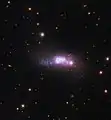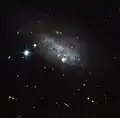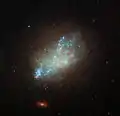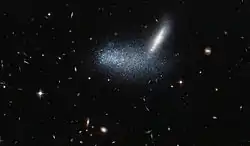.jpg.webp)
An irregular galaxy is a galaxy that does not have a distinct regular shape, unlike a spiral or an elliptical galaxy.[1] Irregular galaxies do not fall into any of the regular classes of the Hubble sequence, and they are often chaotic in appearance, with neither a nuclear bulge nor any trace of spiral arm structure.[2]
Collectively they are thought to make up about a quarter of all galaxies. Some irregular galaxies were once spiral or elliptical galaxies but were deformed by an uneven external gravitational force. Irregular galaxies may contain abundant amounts of gas and dust.[3] This is not necessarily true for dwarf irregulars.[4]
Irregular galaxies are commonly small, about one tenth the mass of the Milky Way galaxy. Due to their small sizes, they are prone to environmental effects like colliding with large galaxies and intergalactic clouds.[5]
Types
There are three major types of irregular galaxies:[6]
- An Irr-I galaxy (Irr I) is an irregular galaxy that features some structure but not enough to place it cleanly into the Hubble sequence.
- Subtypes with some spiral structure are called Sm galaxies
- Subtypes without spiral structure are called Im galaxies.
- An Irr-II galaxy (Irr II) is an irregular galaxy that does not appear to feature any structure that can place it into the Hubble sequence.
- A dI-galaxy (or dIrr) is a dwarf irregular galaxy.[7] This type of galaxy is now thought to be important to understand the overall evolution of galaxies, as they tend to have a low level of metallicity and relatively high levels of gas, and are thought to be similar to the earliest galaxies that populated the Universe. They may represent a local (and therefore more recent) version of the faint blue galaxies known to exist in deep field galaxy surveys.
Some of the irregular galaxies, especially of the Magellanic type, are small spiral galaxies that are being distorted by the gravity of a larger neighbor.
Magellanic Clouds
The Magellanic Cloud galaxies were once classified as irregular galaxies. The Large Magellanic Cloud has since been re-classified as type SBm (barred Magellanic spiral).[8] The Small Magellanic Cloud remains classified as an irregular galaxy of type Im under current galaxy morphological classification, although it does contain a bar structure.
Gallery
 Blue compact dwarf galaxy ESO 338-4.[9]
Blue compact dwarf galaxy ESO 338-4.[9]
 ESO 486-21 is a spiral galaxy with a somewhat irregular and ill-defined structure.[11]
ESO 486-21 is a spiral galaxy with a somewhat irregular and ill-defined structure.[11]
 NGC 2337 is an irregular galaxy that resides 25 million light-years away in the Lynx constellation.[13]
NGC 2337 is an irregular galaxy that resides 25 million light-years away in the Lynx constellation.[13] UGC 4459 is an irregular dwarf galaxy located approximately 11 million light-years away in the constellation of Ursa Major.[14]
UGC 4459 is an irregular dwarf galaxy located approximately 11 million light-years away in the constellation of Ursa Major.[14] Dwarf irregular galaxy known as PGC 18431.[15]
Dwarf irregular galaxy known as PGC 18431.[15] IC 559 is classified as a type Sm galaxy.[16]
IC 559 is classified as a type Sm galaxy.[16]
See also
References
- ↑ Butz, Stephen D. (2002). Science of Earth Systems. Cengage Learning. p. 107. ISBN 978-0-7668-3391-3.
- ↑ Morgan, W. W. & Mayall, N. U. (1957). "A Spectral Classification of Galaxies." Publications of the Astronomical Society of the Pacific. 69 (409): 291–303.
- ↑ Faulkes Telescope Educational Guide – Galaxies – Irregulars
- ↑ Walter, F. et al. Astophys J 661, 102 - 114, 2007
- ↑ Elmegreen, Debra Meloy, and Bruce G. Elmegreen. "Galaxies." Space Sciences, edited by Pat Dasch, vol. 2: Planetary Science and Astronomy, Macmillan Reference USA, 2002, pp. 50-56. Gale Virtual Reference Library, go.galegroup.com/ps/i.do?p=GVRL&sw=w&u=mcc_pv&v=2.1&it=r&id=GALE%7CCX3408800138&asid=f1f899f2eb1f500bc3341c4f13abb896. Accessed 25 September 2017.
- ↑ Gallagher, J. S. & Hunter, D. A. (1984). "Structure and Evolution of Irregular Galaxies." Annual Review of Astronomy and Astrophysics. 22: 37-74. doi:10.1146/annurev.aa.22.090184.000345
- ↑ Grebel, Eva K. (2004). The evolutionary history of Local Group irregular galaxies. in McWilliam, Andrew; Rauch, Michael (eds) Origin and evolution of the elements. Cambridge University Press. p. 234-254. ISBN 978-0-521-75578-8.
- ↑ Corso, G. and Buscombe, W. The Observatory, 90, 229 - 233 (1970) On the spiral structure of the Large Magellanic Cloud
- ↑ "Feeling blue". www.spacetelescope.org. Retrieved 5 November 2018.
- ↑ "A frenzy of stars". www.spacetelescope.org. Retrieved 26 February 2018.
- ↑ "Surveying the cosmos". www.spacetelescope.org. Retrieved 19 June 2017.
- ↑ "Spotlight on IC 3583". www.spacetelescope.org. Retrieved 28 November 2016.
- ↑ "A lopsided lynx". www.spacetelescope.org. Retrieved 9 August 2016.
- ↑ "A distinctly disorganised dwarf". Retrieved 29 March 2016.
- ↑ "Meeting the neighbours". www.spacetelescope.org. ESA/Hubble. Retrieved 8 June 2015.
- ↑ "A spattering of blue". www.spacetelescope.org. ESA/Hubble. Retrieved 8 September 2014.
- ↑ "A cosmic optical illusion". ESA/Hubble Picture of the Week. Retrieved 20 August 2013.